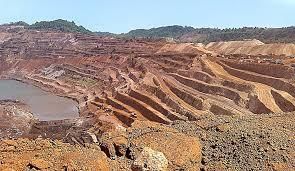GPSC (Goa) Exam > GPSC (Goa) Notes > Goa State PSC (GPSC) Preparation > Goa: Minerals
Goa: Minerals | Goa State PSC (GPSC) Preparation - GPSC (Goa) PDF Download
Minerals of Goa
- General Description:
- Goa is a small, picturesque region on the west coast of the Indian Peninsula.
- The state's rich mineral resources have significantly contributed to its development and industrialization.
- The terrain is primarily hilly, part of the Western Ghats, with altitudes ranging from sea level to 1700 meters above mean sea level.
- Goa enjoys a warm tropical climate with annual rainfall between 350 to 450 cm during the monsoon season (June to October).
- The main rivers, Mandovi and Zuari, flow into the Arabian Sea and are navigable by barges used for ore transport.
- Mineral Resources:
- Goa is endowed with various mineral resources, including economically important minerals such as iron ore, manganese ore, and bauxite.
- There are also minor minerals like basalt, laterite stones and rubbles, river sand, and murrum, which are in high demand for construction.
- Iron Ore Mining:
- Exploration for iron ore began in the early 20th century.
- Modern mining and export of iron ore resumed in 1947, with exports growing from 436,400 tonnes in 1951 to 35 million tonnes in 2008-09.
- Goan iron ore is exported to countries like China, Japan, Taiwan, South Korea, and Eastern Europe.
- Iron ore mining in Goa is entirely private sector-driven.
- Deposits are distributed across the Northern, Southern, and Central Blocks, with the Northern Block having richer deposits in both quality and quantity.
- Goa's infrastructure, including deep sea ports and waterways, provides a significant advantage for exporting.
- Transport and Natural Resources:
- The rivers Mandovi and Zuari facilitate cheap river transport and are crucial for the mining industry.
- The Mormugao Harbour is also a natural resource aiding the industry.
- Bauxite Mining:
- Bauxite mines are located in South Goa, covering an area of 1263.678 hectares with estimated reserves of 70 million tons.
- These reserves are of metallurgical grade bauxite, suitable for various applications such as cement and alumina chemicals.
- The proximity of these mines to major ports like Marmugao and Betul Ports is advantageous.
- Minor Minerals:
- Goa's minor mineral reserves include basalt, laterite, river sand, laterite rubble, laterite boulders, pebbles, murrum, and lime shell.
- Major Minerals:
- The state's major mineral reserves are bauxite, iron ore, and manganese ore.

Iron Ore – Major Minerals of Goa
- The Goan economy heavily relies on the iron ore sector for a significant portion of its regional income, including activities like transport and trade.
- The growth of the iron ore industry in Goa began in 1955 following India's economic embargo.
- Iron ore mining in Goa is entirely privatized, with estimated reserves around 1000 million tonnes.
- The iron ore deposits in Goa predominantly consist of fines, with about 80% being fines and the remainder lumps.
- Notably, lumpy ore in Goa is of lower quality compared to powdery ore, spread across northern, southern, and central blocks of the region.
- The northern block contains richer and higher quantity ore deposits, hosting all major mines producing over a million tonnes.
- Goa benefits from superior infrastructure compared to other exporting regions due to its deep seaport and extensive waterways, facilitating barge transportation.
- Most mines are strategically located near the Mandovi and Zuari rivers, with an average road distance of about 30 km to the river loading points.
- Ore is mechanically loaded onto barges and transported to ports or transhippers, with Goan iron ore primarily geared towards exports, averaging around 30 million tonnes annually.
Question for Goa: MineralsTry yourself: Which major mineral resource heavily contributes to the Goan economy?View Solution
Manganese – Major Minerals of Goa
- Type and Location:
- The manganese deposits in Goa are of the Lateritoid type.
- These deposits are predominantly found in the southern parts of Goa.
- Geological Formation:
- The manganese ore deposits occur as lensoid concordant bodies within pink shales, phyllites, and associated quartzites.
- They are typically located at the edges of plateaus or ridges, where the slope suddenly falls.
- Topographic Features:
- Manganese deposits are often found on small humps, elevations along slopes, and some mounds and knolls.
- They rarely, if ever, occur at the top of plateaus or ridges.
- The deposits form minor anticlinal or domal structures, with maximum ore concentration at the core or apex, diminishing along the slopes.
- Dimensions:
- Individual deposits range in length from 20 meters to 500 meters and in width from 15 meters to 60 meters.
- The depth of concentration varies from 15 meters to 60 meters.
- Ore Quality and Distribution:
- As quarrying progresses into the hill, ore concentration decreases and eventually vanishes into the altered country rock.
- Goan manganese ores contain some iron, which increases as manganese content decreases. Conversely, iron ores also contain some manganese.
- The manganese content in Goan ores generally ranges from 30% to 45%, though it can reach 58% to 60% in some places.
- There are thin concentrations of 2 to 3 meters thick zones of black iron and ferruginous manganese ore above the manganese ore in some deposits.
- Surface and Depth Characteristics:
- Concentration and enrichment of ores are highest at or near the surface, dwindling with depth.
- The upper zones have big boulders and a crude bedded nature, transitioning to smaller boulders and nodules with depth.
Basalt - Minor Minerals of Goa
- The state of Goa, excluding a small area in the northeast, is predominantly composed of rocks from the Dharwar Super group, dating back to the pre-Cambrian era.
- These rocks include various types such as basic intrusive rocks like dolerite and gabbro, as well as acid intrusive rocks like mat greywacke, met basalt, granite, and granite gneiss.
- The northeastern region of the state, on the other hand, is characterized by Deccan traps, which consist mainly of basalt rock.
- Prominent outcrops of these rocks can be found in Pernem, Sattari, Salcete, Sanguem, and Quepem Talukas.
- These rocks are utilized in construction projects, as road materials, and as railway ballast once they are crushed to the necessary size.
- While they vary in composition from granite gneiss to met greywacke, they are collectively referred to locally as Basalt Metal.
- The extraction of these rocks involves quarrying through blasting techniques, with the obtained boulders being crushed into required sizes.
Bauxite / Aluminous Laterite - Major Minerals of Goa
- Composition of Bauxite: Bauxite refers to ores containing at least 45-50% Al2O3, not exceeding 20% Fe2O3, and with 3-5% combined silica. It primarily consists of hydrated aluminum oxides like gibbsite, bohemite, and diaspore, with impurities such as silica, clay, silt, iron hydroxide, and titania. Formed in tropical regions under favorable drainage conditions.
- Geological Context of Goa Bauxite: Goa's bauxite is classified as intertropical deposits associated with laterites originating from metamorphic rocks. The genesis of bauxite involves the alteration of silica, alumina, and iron-rich rocks, resulting in an enrichment of Al2O3 and Fe2O3 by reducing silica content from around 40% to 2-3%.
- Rock Formations in Goa: Goa's geological formations comprise quartzite, quartz-sericite schist, quartz-chlorite schist, metavolcanics, conglomerates, limestone, phyllites, banded ferruginous quartzite, granitic gneisses, and various basic and ultrabasic intrusives from the Precambrian period. Laterites cover these rocks, reaching up to 15m thickness near the coast.
- Pink ferruginous laterite
- Limonitic laterite
- Aluminous laterite
- Bauxitic laterite
- Bauxitic laterite, distinguished by pale pink to flesh red hues, while bauxite itself displays flesh red, cream, and white colors.
- Geographical Distribution of Bauxite Deposits in Goa: Goa's bauxite deposits are categorized by the Geological Survey of India (GSI) into distinct regions, including:
- North Goa Deposits: Encompassing areas like Chapora river, Mopa, Pernem, Morgim, Dargalim, Ibrampur, and Korgaon.
- Central Goa Deposits: Covering locations such as Dabolim, Verna, Canua, Raia, Quessolim, and Sancoale.
- South Goa Deposits: Including regions in southwest Quepem, south of Chauri, Betul, and Polem-Loliem-Galgibaga.
- Minor Occurrences: Scattered instances of aluminous laterite/lateritic bauxite exist across localities like Batim-Porvorim, Carmolim, Colvale, Taleigao-Bambolim, and Calangute.
River Pebbles in Goa
- Formation Process: River pebbles are a result of abrasion and rolling of parent rocks during transportation in streams and rivers from higher elevations.
- Deposition: These pebbles settle along riverbeds where flat surfaces are available.
- Utilization: Manually collected, these pebbles are transported by tipper trucks and primarily used in construction activities for foundations and footings.
Laterite – Minor Minerals of Goa
- Nearly two-thirds of Goa's land area is covered by a layer of laterite, varying in thickness from a few meters to over 25 meters.
- The maximum thickness of laterite is typically found along the western coast, with the minimum thickness along the Eastern Ghat section.
- Laterites in Goa are primarily formed from Quartz-chlorite-Amphibole Schist, Pink ferruginous phyllite, Schistose met basalt, and Met greywacke.
- In construction activities, laterite in Goa is utilized as laterite boulders and stones, locally known as "chira."
- Laterite stones are valued for their unique property of being soft during cutting and gradually hardening over time after use.
- Historically, laterite extraction was done manually, but now it has transitioned to mechanized methods, often employing Power Tillers equipped with Laterite Cutting Blades.
Sand - Minor Minerals of Goa
- Types of Sand:
- Goa has three main types of sand: Ordinary sand, Silica sand, and Beach sand.
- Ordinary Sand Origin:
- Ordinary sand is transported by rivers originating from the Western Ghats and flowing westward into the Arabian Sea.
- Deposition Process:
- The process of weathering contributes to the deposition of sand.
- Collection Sites:
- Sand is primarily collected from the Mandovi, Zuari, Terekhol, and Chapora rivers, along with their tributaries.
- Extraction Methods:
- Upstream, sand is collected manually, screened, and supplied directly.
- In areas with deeper water columns, sand extraction is done using canoes and buckets attached to bamboos.
- Usage:
- Sand is predominantly used for making concrete in construction activities.
Question for Goa: MineralsTry yourself: Which type of minerals are predominantly found in the southern parts of Goa?View Solution
The document Goa: Minerals | Goa State PSC (GPSC) Preparation - GPSC (Goa) is a part of the GPSC (Goa) Course Goa State PSC (GPSC) Preparation.
All you need of GPSC (Goa) at this link: GPSC (Goa)
FAQs on Goa: Minerals - Goa State PSC (GPSC) Preparation - GPSC (Goa)
| 1. What are the major minerals found in Goa? |  |
Ans. The major minerals found in Goa are Iron Ore, Manganese, Bauxite/Aluminous Laterite.
| 2. What are the minor minerals found in Goa? |  |
Ans. The minor minerals found in Goa are Basalt, Laterite, Sand, River Pebbles.
| 3. Which mineral is the most abundant in Goa? |  |
Ans. Iron Ore is the most abundant mineral in Goa.
| 4. What are some of the uses of the minerals found in Goa? |  |
Ans. Iron Ore is used in steel production, Manganese is used in the production of batteries, Bauxite is used in the production of aluminum.
| 5. How does the mining of minerals impact the environment in Goa? |  |
Ans. Mining of minerals in Goa can lead to deforestation, soil erosion, and water pollution, impacting the local ecosystem and biodiversity.
Related Searches




















